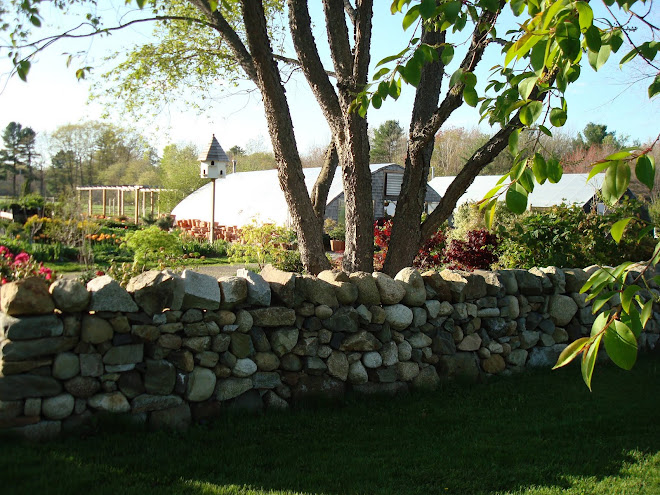

From where I sit right now, I can look outside at the greenhouse and the nursery part of the farm.
I don't mind the stark qualities of winter.
This is the time to evaluate the 'bones' of a garden. This is when in large landscapes you can see the shape of the land, look far into the woods and sometimes see hints of the stream or the marsh or the ocean. It is a time forgotten by many people when they landscape. I drove by a house the other day that had covered up all the bushes near the house with boxes and burlap. I just can't do that. I simply want to enjoy what I look at all year not just for a few months.


Now, occasionally I will cover a tree or shrub for it's first winter just so that it gets established but I really think that you should be planting things that 'can make it' up here. Yes, we will always push the envelope a bit, a Japanese maple here and there or a magnolia that might not be quite hardy in our zone but the majority of plants should be planted so that they will look beautiful against the snow or with ice hanging off their branches. They should provide some structure in the garden that lasts all year and sort of boxes in the messiness of summer opulence.

This is the time for birches and red twigged dogwood and willows. The colors of their branches range from yellows to bright reds, sometimes on the same tree. I remember Michael Dirr, the guru of tree and shrub lovers, showing a slide at one of his lectures that I went to. It was a Winter Flame dogwood, next to a rock, next to a pond in the snow. That did it for me. I have been dropping them into landscapes ever since. It nearly took my breath away.

This is when the papery bark of Acer Grisium, the paperbark maple, just sends you right over the edge, especially if it is planted with the low winter sun back lighting the branches. Microbiata, a low growing shrub that looks similar to juniper but is softer and lacier has beautiful red winter foliage that is the perfect under planting for the paperbark. The colors play off one another and make the land seem warmer.
This is when that Chamaecyparis 'Repens' you planted next to a boulder or nice rock shows up poking through the snow a bit and nestling the rock into the land.
But here also is the time when you see your mistakes and think about back hoes and moving trees and giggle as you buy a 14 inch conifer that will not reach mature height for 15 years.
Oh well, that is for another post.



No comments:
Post a Comment